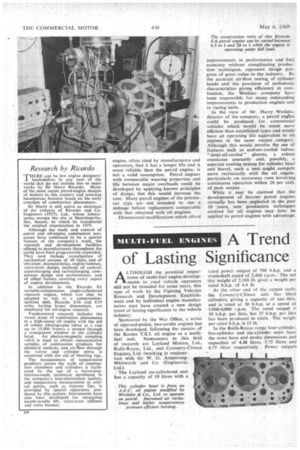Research by Ricardo
Page 122

If you've noticed an error in this article please click here to report it so we can fix it.
ffillERE can be few engine designers' _I. bookshelves in any part of the world that do not include one or more works by Sir Harry Ricardo. Many of the most recent petrol-engine designs of makers in this country and overseas incorporate features based on his early concepts of combustion phenomena.
Sir Harry is still active as chairman of the concern of Ricardo and Co. Engineers (1927), Ltd.. whose laboratories occupy the site at Shoreham-bySea, Sussex, to which he transferred the original organization in 1919.
Although the study and control of petrol and oil-engine combustion processes have continued to be a special feature of the company's work, the research and development facilities offered to manufacturers throughout the world have been progressively expanded. They now include investigation of mechanical stresses of all types and of vibration characteristics, engine balance, valve-train design, methods of control, supercharging and turhocharging, compressor design and performance, and of allied factors covering every aspect of engine development.
In addition to the Ricardo E6 variable-compression single-eylindered research engine, which can also be adapted to run as a compressionignition unit, Ricardo E16 and E19 units, having larger dimensions, are employed for oil-engine research.
Fundamental research includes the visual study of combustion phenomena in a high-speed oil engine with the aid of colour photographs taken at a rate up to 15,000 frames a second through a transparent window in the cylinder head. An electro-magnetic sampling valve is used to obtain representative samples of combustion products for chemical analysis, and air-flow through the valves and cylinder ports is examined with the aid of blowing rigs.
The measurement of temperature gradients across the walls of combustion chambers and cylinders is facilitated by the use of a traversingthermocouple technique developed in the company's instrumentation section, and temperature measurement at critical points, such as injector tips, is provided 1:q+ special apparatus, produced by this section, Instruments have also been developed for measuring nozzle-needle lift, valve-train stiffness and valve bounce.




































































































































































































































































